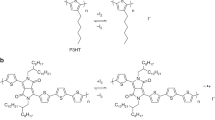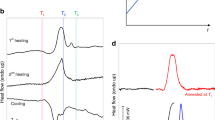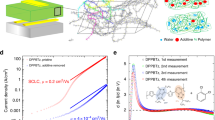Abstract
Self-organization in many solution-processed, semiconducting conjugated polymers results in complex microstructures, in which ordered microcrystalline domains are embedded in an amorphous matrix1. This has important consequences for electrical properties of these materials: charge transport is usually limited by the most difficult hopping processes and is therefore dominated by the disordered matrix, resulting in low charge-carrier mobilities2 (⩽10-5 cm2 V-1 s-1). Here we use thin-film, field-effect transistor structures to probe the transport properties of the ordered microcrystalline domains in the conjugated polymer poly(3-hexylthiophene), P3HT. Self-organization in P3HT results in a lamella structure with two-dimensional conjugated sheets formed by interchain stacking. We find that, depending on processing conditions, the lamellae can adopt two different orientations—parallel and normal to the substrate—the mobilities of which differ by more than a factor of 100, and can reach values as high as 0.1 cm2 V-1 s-1 (refs 3, 4). Optical spectroscopy of the field-induced charge, combined with the mobility anisotropy, reveals the two-dimensional interchain character of the polaronic charge carriers, which exhibit lower relaxation energies than the corresponding radical cations on isolated one-dimensional chains. The possibility of achieving high mobilities via two-dimensional transport in self-organized conjugated lamellae is important for applications of polymer transistors in logic circuits5 and active-matrix displays4,6.
This is a preview of subscription content, access via your institution
Access options
Subscribe to this journal
Receive 51 print issues and online access
$199.00 per year
only $3.90 per issue
Buy this article
- Purchase on Springer Link
- Instant access to full article PDF
Prices may be subject to local taxes which are calculated during checkout



Similar content being viewed by others
References
Samuelsen,E. J. & Mårdalen,J. in Handbook of Organic Conductive Molecules and Polymers Vol. 3 (eds Nalwa, H. S.) 87–120 (Wiley, Chichester, UK, 1997).
Kobashi,M. & Takeuchi,H. Inhomogeneity of spin-coated and cast non-regioregular poly(3-hexylthiophene) films. Structures and electrical and photophysical properties. Macromolecules 31, 7273–7278 (1998).
Bao,Z., Dodabalapur,A. & Lovinger,A. J. Soluble and processable regioregular poly(3-hexylthiophene) for thin film field-effect transistor applications with high mobility. Appl. Phys. Lett. 69, 4108–4110 (1996).
Sirringhaus,H., Tessler,N. & Friend,R. H. Integrated optoelectronic devices based on conjugated polymers. Science 280, 1741–1744 (1998).
Drury,C. J., Mutsaers,C. M. J., Hart,C. M., Matters,M. & deLeeuw,D. M. Low-cost all-polymer integrated circuits. Appl. Phys. Lett. 73, 108–110 (1998).
Dodabalapur,A. et al. Organic smart pixels. Appl. Phys. Lett. 73, 142–144 (1998).
McCullough,R. D. The chemistry of conducting polythiophenes. Adv. Mater. 10, 93–116 (1998).
Prosa,T. J., Winokur,M. J., Moulton,J., Smith,P. & Heeger,A. J. X-ray structural studies of poly(3-alkylthiophenes)—An example of an inverse comb. Macromolecules 25, 4364–4372 (1992).
Fell,H. J., Samuelsen,E. J., Als-Nielsen,J., Grübel,G. & Mårdalen,J. Unexpected orientational effects in spin-cast, sub-micron layers of poly(alkylthiophene)s: A diffraction study with synchrotron radiation. Solid State Commun. 94, 843–846 (1995).
Warren,B. E. X-ray Diffraction 41–50 (Addison-Wesley, Reading, USA, 1969).
Ishikawa,H. et al. Effect of molecular mass of poly(3-alkylthiophene) on electrical properties. J. Phys. D 25, 897–900 (1992).
Schön,J. H., Kloc,C., Laudise,R. A. & Batlogg,B. Electrical properties of single crystals of rigid rodlike conjugated molecules. Phys. Rev. B 58, 12952–12957 (1998).
Deussen,M. & Bässler,H. Anion and cation absorption spectra of conjugated oligomers and polymer. Synth. Met. 54, 49–55 (1993).
Ziemelis,K. E. et al. Optical spectroscopy of field-induced charge in poly(3-hexyl thienylene) metal-insulator-semiconductor structures: Evidence for polarons. Phys. Rev. Lett. 66, 2231–2234 (1991).
Harrison,M. G., Fichou,D., Garnier,F. & Yassar,A. In situ charge-modulation spectroscopy of oligothiophene field-effect diodes: from sexithiophene towards polythiophene. Opt. Mater. 9, 53–58 (1998).
Haare,J. A. E. H. V. et al. Redox states of long oligothiophenes: Two polarons on a single chain. Chem. Eur. J. 4, 1509–1522 (1998).
Horowitz,G., Yassar,A. & Bardeleben,H. J. V. ESR and optical spectroscopy evidence for a chain length dependence of the charged states of thiophene oligomers. Extrapolation to polythiophene. Synth. Met. 62, 245–252 (1994).
Horovitz,B. Infrared activity of Peierls systems and application to polyacetylene. Solid State Commun. 41, 729–734 (1982).
Fano,U. Effects of configuration interaction on intensities and phase shifts. Phys. Rev. 124, 1866–1878 (1961).
Emin,D. Self-trapping in quasi-one-dimensional solids. Phys. Rev. B 33, 3973–3975 (1986).
Blackman,J. A. & Sabra,M. K. Interchain coupling and optical absorption in degenerate and nondegenerate polymers. Phys. Rev. B 47, 15437–15448 (1993).
Sirringhaus,H. et al. Bis(dithienothiophene) organic field-effect transistors with a high ON/OFF ratio. Appl. Phys. Lett. 71, 3871–3873 (1997).
Acknowledgements
We thank J. Cornil, D. Dos Santos, and A. J. Flewitt for contributions. Financial support from the European Commission and the Training and Mobility of Researchers (TMR) programme is acknowledged. H.S. thanks the Royal Society for a University Research Fellowship.
Author information
Authors and Affiliations
Corresponding author
Rights and permissions
About this article
Cite this article
Sirringhaus, H., Brown, P., Friend, R. et al. Two-dimensional charge transport in self-organized, high-mobility conjugated polymers. Nature 401, 685–688 (1999). https://doi.org/10.1038/44359
Received:
Accepted:
Issue Date:
DOI: https://doi.org/10.1038/44359
This article is cited by
-
Cupric ion-functionalized polyaniline/single-walled carbon nanotube hybrids for dimethyl methylphosphonate detection
Journal of Materials Science: Materials in Electronics (2024)
-
Effect of Molecular Weight on Thermoelectric Performance of P3HT Analogues with 2-Propoxyethyl Side Chains
Journal of Wuhan University of Technology-Mater. Sci. Ed. (2024)
-
Heterogeneous Oriented Structure model of thermoelectric transport in conducting polymers
Scientific Reports (2023)
-
Visualizing electroluminescence process in light-emitting electrochemical cells
Nature Communications (2023)
-
Aggregation states, thermal molecular motion and carrier properties in functional polymer thin films
Polymer Journal (2023)
Comments
By submitting a comment you agree to abide by our Terms and Community Guidelines. If you find something abusive or that does not comply with our terms or guidelines please flag it as inappropriate.



